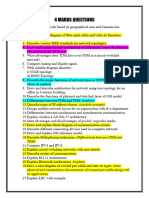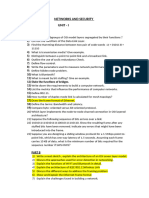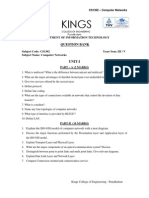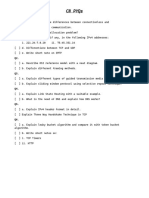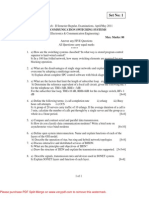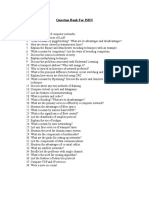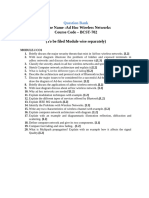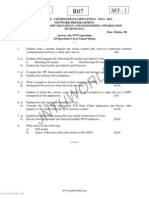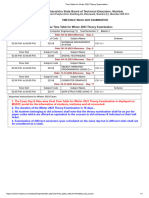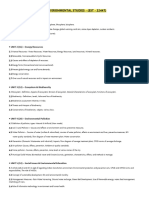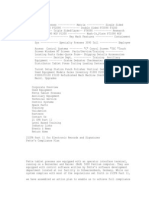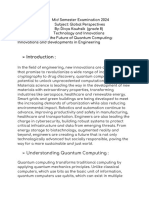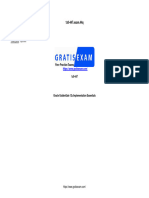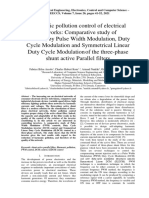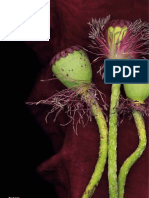0 ratings0% found this document useful (0 votes)
32 viewsDCC - Imp Que
DCC - Imp Que
Uploaded by
pranavchaudhari2017Copyright:
© All Rights Reserved
Available Formats
Download as PDF, TXT or read online from Scribd
DCC - Imp Que
DCC - Imp Que
Uploaded by
pranavchaudhari20170 ratings0% found this document useful (0 votes)
32 views5 pagesOriginal Title
DCC - IMP QUE
Copyright
© © All Rights Reserved
Available Formats
PDF, TXT or read online from Scribd
Share this document
Did you find this document useful?
Is this content inappropriate?
Copyright:
© All Rights Reserved
Available Formats
Download as PDF, TXT or read online from Scribd
Download as pdf or txt
0 ratings0% found this document useful (0 votes)
32 views5 pagesDCC - Imp Que
DCC - Imp Que
Uploaded by
pranavchaudhari2017Copyright:
© All Rights Reserved
Available Formats
Download as PDF, TXT or read online from Scribd
Download as pdf or txt
You are on page 1of 5
DATA COMMUNICATION & COMPUTER NETWORK IMP
QUESTIONS
*UNIT 1 (12) - FUNDAMENTALS OF DATA COMMUNICATION & COMPUTER NETWORK*
Q-1] 2 - MARKS QUESTIONS.
1) Define Computer Network and state it’s types.
2) State various Computer Network applications.
3) Define bit rate and baud rate.
4) List different characteristics of data communication systems. (Any two)
5) Define following terms: (i) Protocol (ii) Bandwidth
6) Name the components of data communication.
7) State any two needs of the Computer Network.
Q-2] 4 - MARKS QUESTIONS.
1) Classify the network based on geographical area and transmission technology.
2) Compare Analog and Digital signals.
3) Draw and explain the block diagram of the communication system.
4) Describe the components of data communication with a neat diagram.
5) Compare LAN and WAN (four points).
6) Describe the various modes of communication in the Computer Network.
7) Consider a network with 8 computers, which network architecture should be used peer to peer or Client
Server ? Justify the answer.
Q-3] 6 - MARKS QUESTIONS.
1) Describe the process of data communication in various modes.
2) Explain simplex, half duplex and full duplex modes in data communication.
3) Explain with a diagram the process of client-server and peer to peer network architecture.
*UNIT 2 (16) - TRANSMISSION MEDIA & SWITCHING*
Q-1] 2 MARKS QUESTIONS.
1) List any four Unguided Transmission Media.
2) Define guided and unguided communication media.
3) List types of multiplexing.
4) Compare guided and unguided transmission media.
Q-2] 4 MARKS QUESTIONS.
1) Draw a structural diagram of fiber optic cable and write its functions.
2) What advantages does TDM have over FDM in a circuit switched Network.
3) Differentiate between FDM and TDM.
4) Draw and explain fiber optic cable.
5) State the two advantages and two disadvantages of unguided media.
6) Describe multiplexing techniques.
7) Differentiate between synchronous and asynchronous
communication. (Any four points.)
8) Draw a neat diagram of twisted pair cable and state its types.
9) Describe line of sight transmission.
10) Compare packet switched and circuit switched networks.
11) Explain satellite communication.
12) Explain TDM technique with the help of neat diagram
13) Explain with a neat diagram working of circuit switching in Network.
14) State the physical and transmission characteristics of twisted pair cable along with its applications.
15) Define multiplexing & compare FDM and TDM.
Q-3] 6 MARKS QUESTION.
1) Why is circuit switching preferred over packet switching in voice communication?
2) Describe the principles of packet switching and circuit switching techniques with a neat diagram.
3) Draw a neat sketch of fiber optical cable. Give the transmission characteristics of fiber optical cable. State its
applications.
*UNIT 3 (12) - ERROR DETECTION,CORRECTION & WIRELESS COMMUNICATION*
Q-1] 2 MARKS QUESTIONS.
1) State types of Errors.
2) List IEEE 802 X standards for networks.
3) Classify mobile generations.
4) Compare LRC and CRC (Any two points each.)
5) Compare LRC and VRC.
Q-2] 4 MARKS QUESTIONS.
1) Describe various IEEE standards for network topologies.
2) Explain various IEEE communication standards.
3) Explain wireless LAN 802.17 architecture.
4) Explain 802.11 Architecture.
5) Explain LRC with examples.
6) Describe various mobile generations in detail.
7) State features of various mobile generations.
8) Draw the architecture of bluetooth and explain.
Q-3] 6 MARKS QUESTIONS.
1) A system uses CRC on a block of 8 bytes. How many redundant bits are sent per block? What is the ratio
of useful bits to the total bits?
2) What is the MAC protocol used in Token Ring LAN’s? What happens if the token is lost.
3) Describe bluetooth architecture technologies.
4) Draw the architecture of wireless LAN 802.11 and explain.
*UNIT 4 (10) - NETWORK TOPOLOGIES & NETWORK DEVICES*
Q-1] 2 MARKS QUESTIONS.
1) Compare Router and Repeater.
2) State different types of Network topologies.
3) List different types of network connecting devices.
4) State the function of repeater and modem.
Q-2] 4 MARKS QUESTIONS.
1) With suitable diagram describe: (i) STAR topology (ii) RING topology
2) Draw and describe architecture for network using tree topology for an office in 3-storey’s building
3) Describe different connecting devices used in computer networks.
4) Differentiate between HUB and switch with respect to Layer, Port, device type, speed.
Q-3] 6 MARKS QUESTIONS.
1) What is the MAC protocol used in Token Ring LAN? What happens if the token is lost?
2) Describe wireless infrastructure components in detail.
3) Explain the working of following topologies : (i) Bus (ii) Ring (iii) Tree
4) Explain the working of the hub, switch and bridge.
5) Explain with the neat sketch the working of Router and switch.
*UNIT 5 (20) - REFERENCE MODELS*
Q-1] 2 MARKS QUESTIONS.
1) State functions of Network layer.
2) List classes of IP addressing with their IP address range.
3) List classes of IP addresses.
4) State the services of the transport layer in the OSI model.
Q-2] 4 MARKS QUESTIONS.
1) Draw and explain layered architecture of OSI model.
2) Describe major functions of the network layer in the TCP/IP protocol suite.
3) Describe functions of the physical layer and data link layer of the OSI model.
4) Describe types of IP address classes.
5) State the functions of any two layers of the OSI model.
6) Draw and explain OSI reference model.
7) Compare IPV4 and IPV6. (Any four points.)
8) Draw and explain the TCP/IP model.
9) List the protocols related to all layers of the OSI reference model.
10) Describe the process of DHCP server configuration.
11) Draw and explain TCP/IP protocol suite.
12) State the OSI models Layer and give its functions.
13) Describe various IP address classes with a suitable example.
Q-3] 6 MARKS QUESTIONS.
1) Your company has the network id 165.130.0.0. You are responsible for creating subnets on the network, and
each subnet must provide at least 1000 host ids. What subnet mask meets the requirement for the minimum
number of host ids and provides the highest number of subnets?
2) Describe the process of DHCP server configuration.
3) Explain configuration of TCP/IP protocol in the network.
4) Explain the process of DHCP server configuration.
5) Describe the procedure to configure the TCP/IP network layer services.
6) Explain the working of OSI model layers.
7) Explain ARP, subnetting and supernetting with an example.
8) Describe the terms with a suitable example i) Subnetting ii) Supernetting iii) Masking.
9) Describe the procedure to configure TCP/IP network layer services.
You might also like
- Windows Server 2012R2Document55 pagesWindows Server 2012R2Viorel StefanescuNo ratings yet
- Lenovo Thinkpad E495 E595 LCFC PICASSO EX95 JINN - DOOKU 2.0 FE495 - FE595 NM-C061 Rev 1.0 (0.1)Document65 pagesLenovo Thinkpad E495 E595 LCFC PICASSO EX95 JINN - DOOKU 2.0 FE495 - FE595 NM-C061 Rev 1.0 (0.1)Jose Mauro de SouzaNo ratings yet
- Data Communications and Computer Networks Faq'S: Unit 1Document4 pagesData Communications and Computer Networks Faq'S: Unit 1Shruthi JalalpuramNo ratings yet
- Sem-4 DCC 4 Marks IMPsDocument2 pagesSem-4 DCC 4 Marks IMPssaqibzuber813No ratings yet
- DCCQBDocument4 pagesDCCQBGame KingNo ratings yet
- IIbca cn model papersDocument7 pagesIIbca cn model paperssowprincess143No ratings yet
- DC Imp QuestionsDocument3 pagesDC Imp QuestionsdeekshachennamshettyNo ratings yet
- Information Technology V Sem Set 2Document2 pagesInformation Technology V Sem Set 2aniruthgsabapathyNo ratings yet
- NETWORKS AND SECURITY IMPORTANT QUESTIONSDocument8 pagesNETWORKS AND SECURITY IMPORTANT QUESTIONSBuvan SivaNo ratings yet
- Question Bank Unit 1-2Document3 pagesQuestion Bank Unit 1-2Vikas ManchalNo ratings yet
- CS1302 - Computer NetworksDocument5 pagesCS1302 - Computer Networkslm_zakaria4420No ratings yet
- CN NotesDocument116 pagesCN Notesdumacc000.111No ratings yet
- DCN 2171008 AssignmentDocument4 pagesDCN 2171008 AssignmentRAMSHI CHETARIYANo ratings yet
- Computer Networks Year Question BankDocument5 pagesComputer Networks Year Question Bankakhilek100% (1)
- CN QuestionsDocument5 pagesCN Questions21131a03a5No ratings yet
- 18it502 - DCCN - Question Bank-1Document6 pages18it502 - DCCN - Question Bank-1SHANMUGAM SNo ratings yet
- Question BankDocument5 pagesQuestion BankArvindNo ratings yet
- Telecommunication Switching SystemsDocument4 pagesTelecommunication Switching SystemsUday RokxNo ratings yet
- MCN Question Bank Mid SemDocument1 pageMCN Question Bank Mid SemSinley PatelNo ratings yet
- CN MODIFIED QUESTIONSDocument3 pagesCN MODIFIED QUESTIONSજીવન અવિનાશ કનુગુલાNo ratings yet
- Ec3401 2marksDocument3 pagesEc3401 2marksbhuvanaNo ratings yet
- Computer Network-1 IA Question BankDocument5 pagesComputer Network-1 IA Question BankVeena GadadNo ratings yet
- K. K. Wagh Polytechnic, Nashik.: Department of Computer TechnologyDocument1 pageK. K. Wagh Polytechnic, Nashik.: Department of Computer Technology16FYCM-IDhakane Aditya ArunNo ratings yet
- Ec2352 Computer Networks Question Bank CNDocument4 pagesEc2352 Computer Networks Question Bank CNMuhamed HajaNo ratings yet
- CS2361 CN Im 2013 PDFDocument2 pagesCS2361 CN Im 2013 PDFsaravana102030No ratings yet
- CN - All Unitwise Question BankDocument6 pagesCN - All Unitwise Question Bankmmit123100% (1)
- CN Question BankDocument5 pagesCN Question BankPavan Kumar0% (1)
- Set No: 1: Code No: V3224/R07Document4 pagesSet No: 1: Code No: V3224/R07jitendra28No ratings yet
- QP April2011 32 Ece TssDocument4 pagesQP April2011 32 Ece TssJoshua DuffyNo ratings yet
- Review QuestionsDocument4 pagesReview Questionsgallenkayombo1No ratings yet
- @vtucode - in - CN QUESTION BANK 2021 SCHEMEDocument7 pages@vtucode - in - CN QUESTION BANK 2021 SCHEMEvinaykumarms343No ratings yet
- CSE306 Imp 2Document2 pagesCSE306 Imp 2pancham8256No ratings yet
- Corrections Links: Unit: IDocument5 pagesCorrections Links: Unit: ISonaAnnyaNo ratings yet
- Model Paper by SriDocument5 pagesModel Paper by SriM.A rajaNo ratings yet
- Mid 2 - 3 Sets Telecommunication Switching Systems and NetworksDocument3 pagesMid 2 - 3 Sets Telecommunication Switching Systems and NetworksSony RamaNo ratings yet
- 10M CN Question BankDocument2 pages10M CN Question Bankvsureshkumar1116No ratings yet
- Prof.pnp .Cnd22634 Tyej(1)Document22 pagesProf.pnp .Cnd22634 Tyej(1)sonal.beladarNo ratings yet
- QB-CN-1Document8 pagesQB-CN-1sandeep rangariNo ratings yet
- CS6551 Computer NetworksDocument7 pagesCS6551 Computer NetworksMogili sivaNo ratings yet
- Computer NetworksDocument9 pagesComputer NetworkspriyaaramNo ratings yet
- ISDN Question BankDocument3 pagesISDN Question Bankmaithuong85No ratings yet
- 231 Computer NetworkDocument5 pages231 Computer Networksumanth 786No ratings yet
- AMIE-Computer Network Old Question SortedDocument10 pagesAMIE-Computer Network Old Question Sortedsandeepharidas100% (3)
- 477Document4 pages477Joshua DuffyNo ratings yet
- Sem-4 DCC 6 Marks IMPsDocument2 pagesSem-4 DCC 6 Marks IMPssaqibzuber813No ratings yet
- Imp QuestionsDocument2 pagesImp QuestionskeralekarNo ratings yet
- DCC ImpDocument4 pagesDCC ImpAnirudha JadeNo ratings yet
- CN Eot 307 Question BankDocument5 pagesCN Eot 307 Question BankAli AshirNo ratings yet
- CS2302 Computer Networks Important QuestionsDocument1 pageCS2302 Computer Networks Important QuestionsSonaAnnyaNo ratings yet
- CN QuestionsDocument4 pagesCN Questionsashish3686No ratings yet
- CN Question BankDocument4 pagesCN Question BankSeemon BhadoriaNo ratings yet
- Question Bank of adhoc wireless networkDocument4 pagesQuestion Bank of adhoc wireless networkAbhishek RawatNo ratings yet
- Question Bank Unit 4 Unit 5Document3 pagesQuestion Bank Unit 4 Unit 5ShriyaNo ratings yet
- Computer Network and Security, All The Module Question Bank VtuDocument3 pagesComputer Network and Security, All The Module Question Bank VtubibliophileonthesamepageNo ratings yet
- DCC Assignment No.2Document1 pageDCC Assignment No.2shradhachavan2006No ratings yet
- CN PyqsDocument3 pagesCN PyqsVVLNo ratings yet
- Question Paper Code:: (10×2 20 Marks)Document2 pagesQuestion Paper Code:: (10×2 20 Marks)GOJAN ECENo ratings yet
- QB DC1Document19 pagesQB DC1Loryliza M DeiparineNo ratings yet
- 07a7ec19 Network ProgrammingDocument4 pages07a7ec19 Network ProgrammingNaveen KumarNo ratings yet
- CCST Cisco Certified Support Technician Study Guide: Networking ExamFrom EverandCCST Cisco Certified Support Technician Study Guide: Networking ExamNo ratings yet
- 150 DSA QuestionsDocument9 pages150 DSA Questionspranavchaudhari2017No ratings yet
- Unitwise MCQ - Technical PublicationsDocument24 pagesUnitwise MCQ - Technical Publicationspranavchaudhari2017No ratings yet
- Basic Science (Physics & Chemistry)Document11 pagesBasic Science (Physics & Chemistry)pranavchaudhari2017No ratings yet
- Time Table For Winter 2023 Theory ExaminationDocument1 pageTime Table For Winter 2023 Theory Examinationpranavchaudhari2017No ratings yet
- Diploma 5th Sem - SyllabusDocument6 pagesDiploma 5th Sem - Syllabuspranavchaudhari2017No ratings yet
- 21CFR, Fette AmericaDocument5 pages21CFR, Fette AmericaleotrevinoNo ratings yet
- Evolution of NetworksDocument21 pagesEvolution of NetworksScribd Dot ComNo ratings yet
- CST 3 Sem Data Structures 307 3 N Jun 2022Document3 pagesCST 3 Sem Data Structures 307 3 N Jun 2022Manik SinghNo ratings yet
- Understanding Quantum ComputingDocument6 pagesUnderstanding Quantum ComputingDivya KaushikNo ratings yet
- Oracle Prep4sure 1z0-447 v2018-07-19 by Andy 44qDocument21 pagesOracle Prep4sure 1z0-447 v2018-07-19 by Andy 44qsg17068666No ratings yet
- Vision and Scope SampleDocument21 pagesVision and Scope SampleShoaib KhanNo ratings yet
- ARM System On Chip DesignDocument25 pagesARM System On Chip DesignutkangencpsnNo ratings yet
- Document Numbering Procerdure Rev 1Document1 pageDocument Numbering Procerdure Rev 1Mohammed AshrafNo ratings yet
- Business Classified Script User: Sign Up/RegisterDocument7 pagesBusiness Classified Script User: Sign Up/RegisterEric PetersonNo ratings yet
- حل امنیتDocument12 pagesحل امنیتErfan Gholami Qadikola50% (2)
- MPLAB - Harmonyv3 - Application - Development - Guide - For - MPLAB - Harmonyv2 - Users - DS00003388ADocument41 pagesMPLAB - Harmonyv3 - Application - Development - Guide - For - MPLAB - Harmonyv2 - Users - DS00003388AAldo HernandezNo ratings yet
- Class 11 Compsci QP 21.12.22Document6 pagesClass 11 Compsci QP 21.12.22talkativenesssaiNo ratings yet
- Article Biloa FinalDocument12 pagesArticle Biloa FinalBILOANo ratings yet
- Alr22476 RevDocument13 pagesAlr22476 Revplz sub me whant moniNo ratings yet
- TENSORRTDocument26 pagesTENSORRTvineet yadavNo ratings yet
- Programming Techniques - PythonDocument37 pagesProgramming Techniques - Pythonlakmini gunarathnaNo ratings yet
- Wireless LCD Display Via Bluetooth - Full Electronics Project PDFDocument3 pagesWireless LCD Display Via Bluetooth - Full Electronics Project PDFTECH IDEASNo ratings yet
- Logix5000 Controllers - CPU Clock SpeedsDocument3 pagesLogix5000 Controllers - CPU Clock SpeedsMarisolNo ratings yet
- LIU-0832WN User ManualDocument8 pagesLIU-0832WN User Manualmoustache237No ratings yet
- Sta Constraints Nandan RoyDocument6 pagesSta Constraints Nandan RoyAvas RoyNo ratings yet
- Scanning The Natural World - Janet DwyerDocument5 pagesScanning The Natural World - Janet Dwyerjanetdwyer100% (1)
- Speeduino Manual PDFDocument107 pagesSpeeduino Manual PDFJose100% (1)
- Deep Learning NotesDocument14 pagesDeep Learning NotesbadalrkcocNo ratings yet
- Bluedart Express LTD - Tracking Details PDFDocument1 pageBluedart Express LTD - Tracking Details PDFvinay kumarNo ratings yet
- AbstractionDocument6 pagesAbstractionsiddhant kudesiaNo ratings yet
- Data Lake or Data Swamp?Document16 pagesData Lake or Data Swamp?Kira HoffmanNo ratings yet
- Lecture: Ir. M. Zaenal Efendi, MT.: Electronic Engineering Polythechnic Institute of SurabayaDocument19 pagesLecture: Ir. M. Zaenal Efendi, MT.: Electronic Engineering Polythechnic Institute of SurabayaApry PermatasariNo ratings yet
- StopWatch CDocument6 pagesStopWatch CInderJeet Gehlot100% (1)



